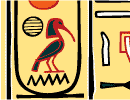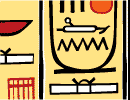|
EgyptRevealed.com -- Cleopatra's Sunken Palace (continued)
Goddio's
first step in searching for the drowned history was to dispatch the
research ship Kaimiloa, packed with sonar and trailing magnetometers, to
build a magnetic and sound-based picture of the underwater site. For three
months, the ship crisscrossed the harbor, producing a fuzzy map filled
with hints and promises but short on detail. Only divers could fill in the
blanks.
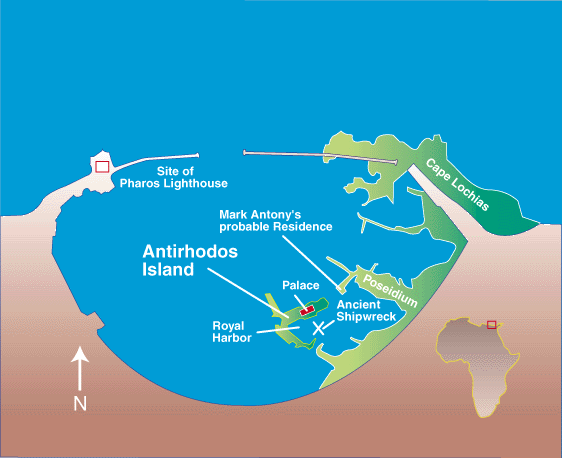
The entire remapping project, said Dr. Emily Teeter of the University
of Chicago's Oriental Institute, "is fundamental to our understanding of
the ancient city and its ritual and governmental functions. It is amazing
how much the harbor topology, as recreated from Strabo, is different from
what Goddio reconstructed."
Goddio found Antirhodos Island on the opposite side of the harbor from
where it was placed by Strabo. Antony’s residence, Timonium, was also
misplaced by the ancient geographer, as were the royal harbor and other
features. Recent re-examinations now suggest the fault was not Strabo’s
but centuries of faulty translations.
Armed with the new harbor map, Goddio's team took to the water in June
1996. Despite having to bundle up in masks and protective suits to avoid
the city sewage, the divers averaged two 100-minute dives a day. They have
posted more than 3,550 exploratory dives.
What first looked like a barren waste was transformed -- after dredges
began vacuuming away the layers of sediment -- into a buried wonderland of
columns and statues and pavement. Diving archaeologists began finding
vessels and artifacts, especially amphorae, the popular wine jugs of the
era.
And resting incongruously amid the debris of a violent antiquity was
the spoor of an equally violent present: the wreckage of a British bomber
shot down in World War II.
The royal harbor took on a more precise shape. The island of
Antirhodos, most likely the site of Cleopatra’s palace, and its shoreline
were roughly defined. The breakwater that held Antony’s residence was
tentatively identified.
The ground rules for Goddio's seven-year project require that artifacts
remain in place after being precisely located, mapped, and cataloged.
Molds were made underwater for many of the finds. A few of the larger
items were hoisted temporarily to the surface to make complete molds, then
were returned to the safety of the depths.
The divers hauled to the surface dramatic stone statues, including
sphinxes that portray Ptolemic rulers, one of them most likely Cleopatra’s
father. A large, black-granite head found along the ancient shoreline was
raised, along with a sphinx some 90 centimeters (35 inches) long and 62
centimeter (24 inches) high, and another almost half again as large.
|
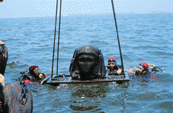
|
Submerged artifacts
discovered in the ancient royal harbor of Alexandria.
Photograph courtesy of Discovery
Channel
|
The growing array of amphorae, pots, lamps, cups, wine flasks, coins,
rings, granite columns, pavement, and statuary – among more than 2,000
artifacts – have helped the archaeologists decipher much of the royal
city's geography. One of the most dramatic items to emerge was a
128-centimeter (50-inch) tall statue of a priest. "As soon as it came out
of the water, it was clear that it was a male priest of the god
Osiris-Hydreios; often called Canopus," said Teeter, who made the field
identification. "The god Osiris-Hydreios [held by the priest] is in the
form of a jar with a human-headed lid. That form is shared by Canopic jars
that were used for mummification."
Canopus is related to the Egyptian mythological figure Isis. Historical
records note that the Temple of Isis was on Antirhodos. Should the statue
prove to be part of the temple complex, it would provide one more piece of
the puzzle for reconstructing a precise map of Ptolemies.
"From our excavations on the sunken island," says Goddio, "we've found
that, at one point, it was completely leveled and paved. Much of the
pavement is still intact. What we are finding are the remains of toppled
structures with no exact indication of what the buildings were. It is the
surrounding artifacts that are shedding light in this area."
A statue of the head of a falcon, representing the god Horus, who was
often associated with rulers, may help locate various temples, as might a
white-marble statue from the southern tip of Antirhodos.
|
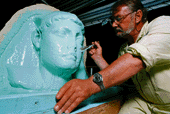
|
Photograph courtesy of
Discovery Channel
|
Keeping track of all these pieces of the past is the task of engineer
Jean-Jacques Groussard. "Because of the uniqueness of the mission," he
said, "we were required to write a special computer program to maintain
the vast artifacts’ database. With this program, we were able to provide
the longitude and latitude -- from a Global Positioning System reading --
of the object, give it a reference number, enter it into a class, provide
an archaeological grid number, dimensions, material of construction, and
even enter a photograph of the piece."
Assembling the puzzle pieces into a cohesive picture will be even more
complicated. Classical archaeologist Fawzi A.R. el Fakharani of Alexandria
University said: "While previous theories on the location of ancient
Alexandria have been pure speculation, the map drafted and the work
performed by Goddio’s team for the first time gives us a clear idea of the
ancient royal district. What we see today is unique -- an underwater
survey of the most important part of Alexandria at its zenith."
Archaeologists may be working in this harbor for 50 years to come. "We
still have much to do," Goddio says. "The finds thus far do not tell the
story of Cleopatra nor of her palace, with the precious wood doors
decorated in tortoise shells and emeralds, or the fine carpets, and
alabaster and gold that Roman poet Lucan wrote about. He told of floors of
onyx with ivory on all sides."
And what of that fascinating shipwreck?
"We were thrilled," Goddio said. "Its state of preservation is amazing.
Radiocarbon dating determined the wreck may have come from the first
century B.C. to A.D. 50, placing it at the end of the Ptolemaic and
beginning of Roman rule."
Patrice Sandrin was in charge of excavating the ship, which measured 30
by 8.5 meters (99 by 29 feet). Among the amphorae, pots, cups, saucers,
and animal bones found within the wooden framework were items that hinted
at a female presence. "I was diving over the shipwreck and happened to
glance down," recalls Stephane Brousse. "I noticed a reflection on what
would have been the starboard side of the vessel. Looking closer, I found
a tiny gold ring with gemstones." A second ring and an ivory hairpin were
found soon after.
"Locating the wreck in the tiny, royal harbor of the Island of
Antirhodos is a major find," Goddio said. "It is too early, however, to
say exactly what type of ship it is. The items we have found in the
wreckage ñ oil and wine vases as well as other luxury items -- would
indicate it is not a cargo ship."
Whose ship was it? Goddio is understandably reluctant to speculate --
pending much more evidence -- about the woman who may have stood on its
decks when Alexandria was one of the most glorious cities in the world.
|
